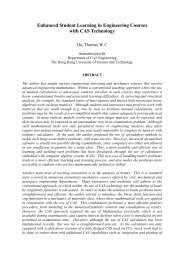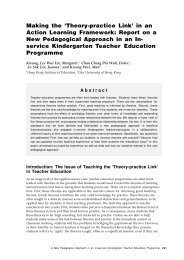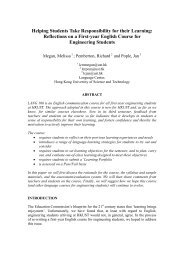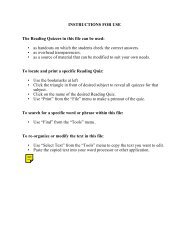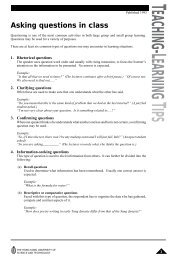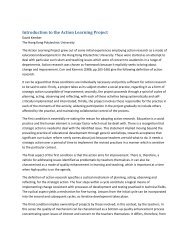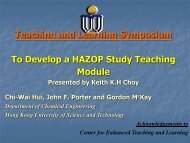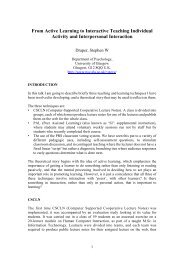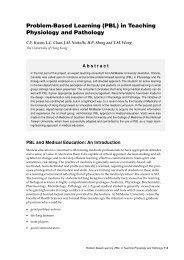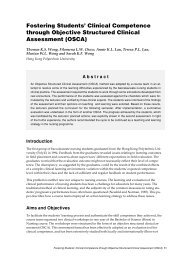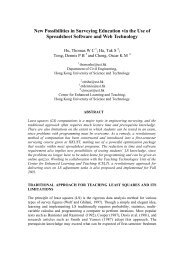Introducing Problem-Based Learning to Teacher Education ...
Introducing Problem-Based Learning to Teacher Education ...
Introducing Problem-Based Learning to Teacher Education ...
You also want an ePaper? Increase the reach of your titles
YUMPU automatically turns print PDFs into web optimized ePapers that Google loves.
suggested that the design of the central problem must be well balanced and thought through.<br />
This is also the difficulty faced by many PBL programmes.<br />
Third Cycle<br />
Central <strong>Problem</strong><br />
In this last cycle, the central problem was carefully designed <strong>to</strong> focus mainly on the learning and<br />
teaching aspects of the new technical curriculum.<br />
The current prevocational and secondary technical curriculum is undergoing extensive<br />
reviews. Some outdated subjects will be removed while new technology/business subjects<br />
will be introduced in the year 2000. Consequent <strong>to</strong> this move, the need <strong>to</strong> review the<br />
teaching approaches with reference <strong>to</strong> the teaching resources available is apparent. You<br />
are the panel chair of technical subjects in a prevocational or technical school. Your brief<br />
is <strong>to</strong> review the impact of such change on the learning and teaching quality of<br />
technology/business subjects and <strong>to</strong> make recommendations on the teaching approaches<br />
appropriate <strong>to</strong> the new technical curriculum. (Technical <strong>Teacher</strong>s Certificate Course<br />
1999/2000, HKIEd)<br />
Sub-problems<br />
The sub-problems were more focused in this round. They basically centred around issues relating<br />
<strong>to</strong> curriculum, pedagogy and resources and the impacts of the curriculum changes upon teachers<br />
and students. The sub-problems derived by the students included the following.<br />
• Demands for teacher retraining as a result of the curriculum change;<br />
• Need for replacing the old equipment and facilities;<br />
• Comparison of traditional and new teaching approaches;<br />
• Impacts of new teaching approaches on practicing teachers and students;<br />
• Issues relating <strong>to</strong> curriculum, pedagogy and resources …;<br />
• Changes in subject knowledge and teaching aids;<br />
• Any change in the aims of technology education;<br />
• Limitations of the current teaching approaches.<br />
<strong>Learning</strong> Process<br />
Students managed <strong>to</strong> present their solutions <strong>to</strong> the problem in three weeks. Their learning<br />
approaches were similar <strong>to</strong> the previous two groups. There was not much frustration<br />
demonstrated during the process. This might be attributed <strong>to</strong> the clear focus of the central<br />
problem. Some students expressed that they initially viewed the problem in a rather abstract<br />
way. This perception had, however, gradually becoming more concrete as they gathered more<br />
information about the curriculum change.<br />
Feedback<br />
Most students believed that the level of difficulties of the problem was appropriate (4.0 in a 5-<br />
point scale). They enjoyed the learning process (3.7 as compared <strong>to</strong> 2.8 in the second cycle), and<br />
they generally supported the introduction of PBL in<strong>to</strong> other modules within the TTC curriculum.<br />
Some of their comments are summarised below.<br />
<strong>Introducing</strong> <strong>Problem</strong> <strong>Based</strong> <strong>Learning</strong> <strong>to</strong> <strong>Teacher</strong> <strong>Education</strong> Programmes 287



